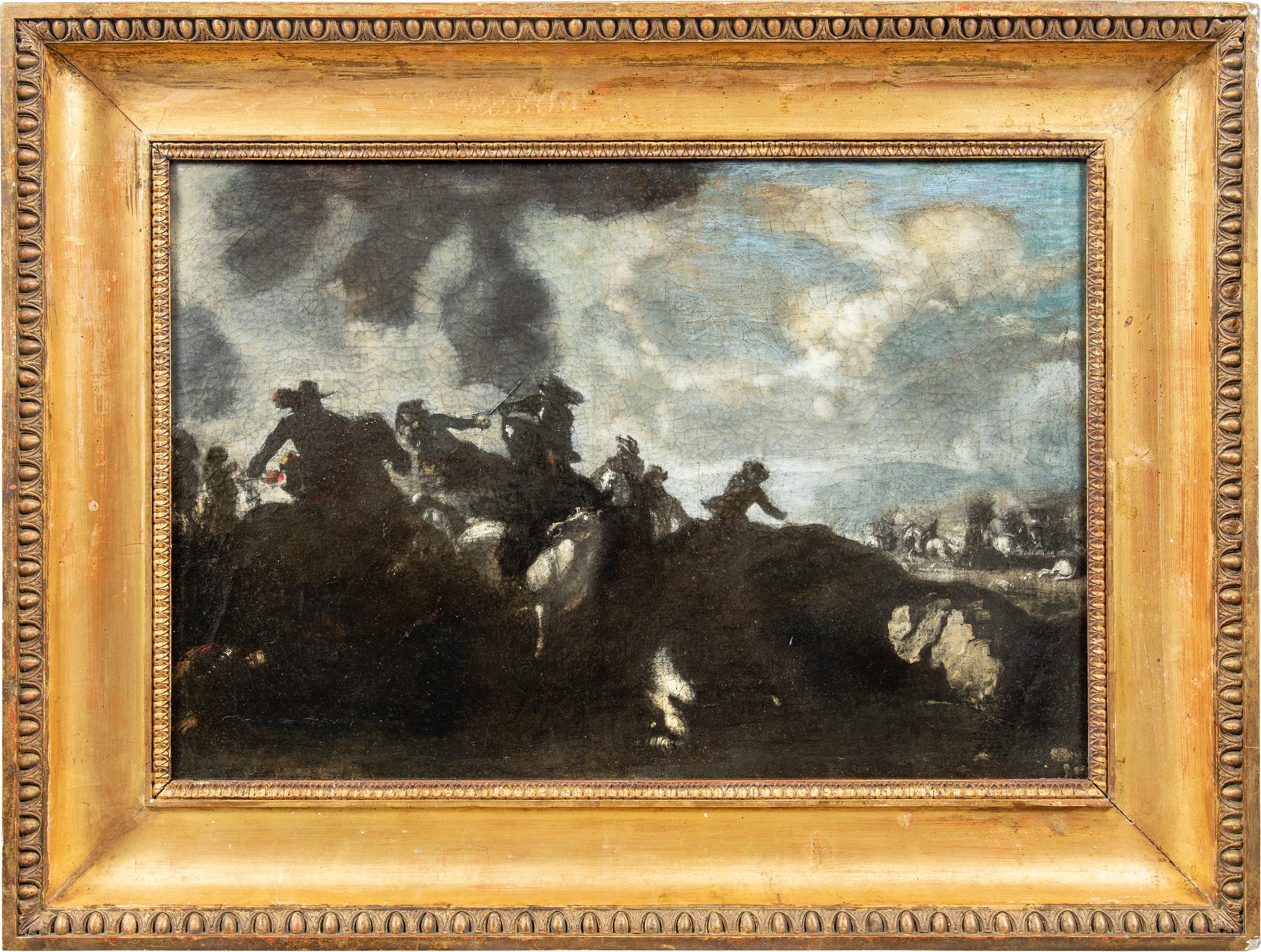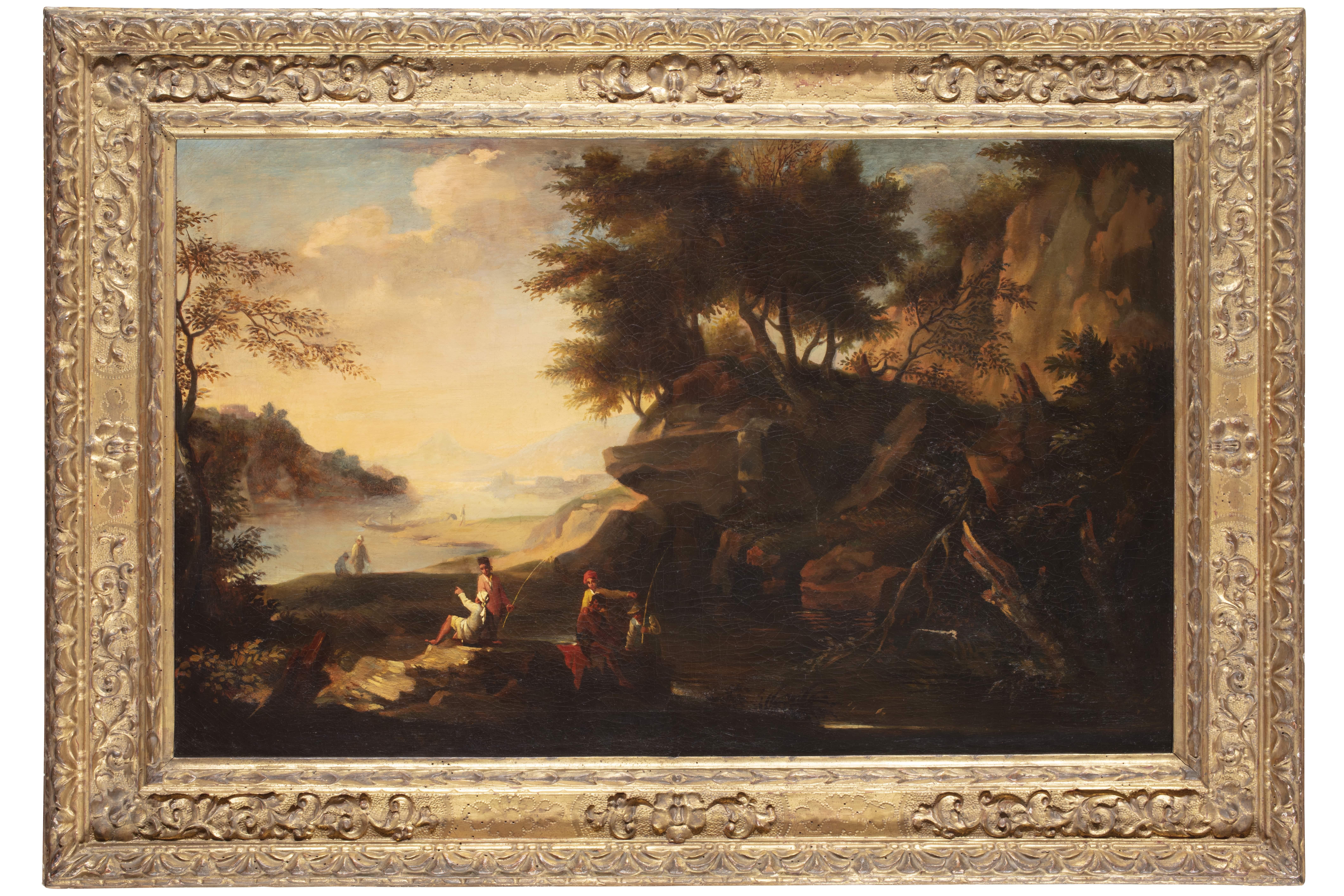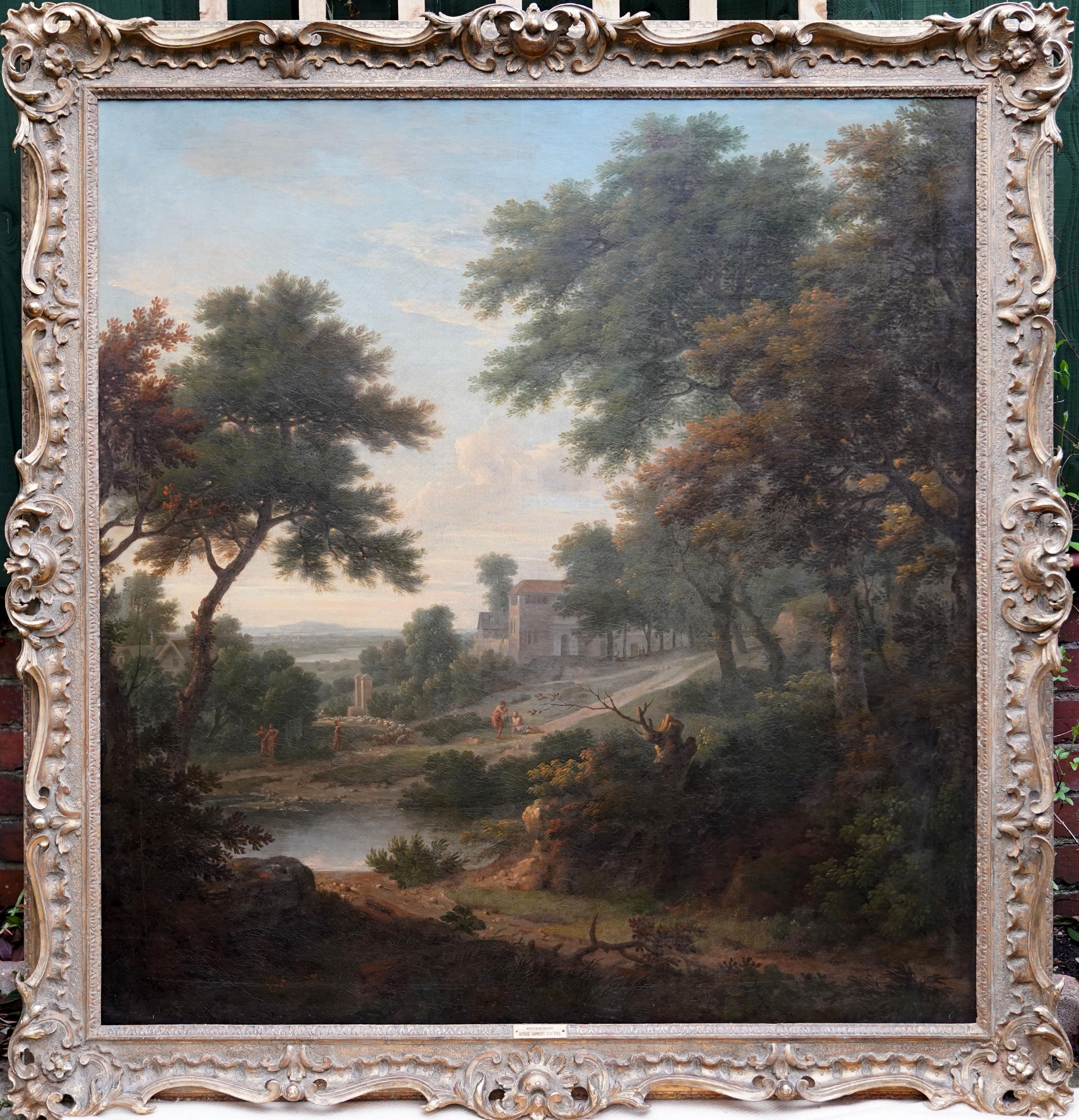Items Similar to Horses and stagecoach winter/snow scene, oil painting, by John Richard Worsdale
Want more images or videos?
Request additional images or videos from the seller
1 of 12
John Richard WorsdaleHorses and stagecoach winter/snow scene, oil painting, by John Richard Worsdale19th century
19th century
About the Item
A fine antique oil painting of horses pulling a stagecoach in snow , by John richard Worsdale (1869-1947)
The artist portrays this powerful scene with an extensive view, featuring the stagecoach pulled by 4 horses
and a village scene behind with buildings and peopla with another coach behind.
oil on canvas, signed lower left, housed in a gilt frame.
The size of the painting is approx 74 cms x 49 cms, whilst framed size is 90cm x 67cm.
The painting is in very good condition, relined, with only some minor craquelure to the skyline,
The frame appears original and is also in good condition with only minor age wear.
Provenance: The E. W. Towler Collection, formerly of Glympton Park, Woodstock, Oxfordshire.
Eric W. Towler was a remarkable man. He was born in 1900 and left school at the age of 12 to work in a Yorkshire pit and through a lifetime of hard work, self-improvement, luck and a refusal to limit his horizons achieved many of his aspirations.
As a Yorkshireman through and through, he believed in ‘spending the brass in his pocket’ and over time he was successful enough to acquire enough ‘brass’ to enable his purchase of Glympton Park and furnish it as a traditional country house with all the trappings – in his case collections of antique furniture, rugs, sporting oils and clocks.
His first step was to move from the pit to an apprentice as a bank clerk, where he claimed to have learned to ‘mek the tea’ but seems also to have acquired skills in book-keeping, which after a period as an Able Seaman in the RNVR during the end of the first world war, served him well in his future entrepreneurial journey. At the age of twenty-one, he vouchsafed all he had into a small coal dealing business, where his gift for sales led to an early invitation to be their Sales Director, and the rest is history.
Early in his life, Eric was able to achieve one of his aspirations. He described looking in awe through the gates of Tong Hall – a large Yorkshire property in a rural location near his home and during his thirties, funded by his growing success in a variety of industrial entrepreneurial roles, he was able to acquire it, and instead look out through the gates. This was first of a series of substantial properties, and his interest in farming.
His down to earth nature, knowledge and interest in newly emergent farming technologies led to a productive collaboration with Tom Williams, who was set the task of digging for Britain as Minister of Agriculture, and he continued his interest in farming through a number of estates in Yorkshire, Shropshire and Somerset before eventually settling at Glympton Park in Oxfordshire. Here he stewarded the development and modernisation of a large mixed estate covering everything from cereals, the latest forage crops to his pedigree Red Devon beef cattle, Suffolk sheep, dairy cows and pigs.
Eric was keen to enjoy every aspect of the land, and loved country sports and shooting, but particularly enjoyed fox hunting – a passion he continued for life. He managed to become Joint Master of the Badsworth Hunt in his early thirties, with the force and accessibility of his personality overcoming what some saw as a limitation of his humble background. When not on the hunting field his interest in horses extended from the practicalities of carriage driving to sporting oils, notably by Ferneley and Herring some of which are in this auction.
In Oxfordshire, in true renaissance style, he diversified from business to health service management as Chairman of the Nuffield, the Radcliffe, United Oxford Hospitals thus ‘ticking off’ another aspiration of his to be a doctor (as he initially saw it). This is a reflection of his compassionate nature to relieve suffering, which we can perhaps understand when he describes the only access to dentistry in the Yorkshire village of his childhood around 1910, being the village policeman who would attempt its removal with a pair of pliers. Much of the credit for planning of the John Radcliffe goes to Eric, and for all of this he was awarded the C.B.E and an honorary M.A by Oxford University. Various hospital features now proudly bear his name.
Eric W. Towler was known for his deep kindness, generosity, and desire to help others, especially the young. He was truly a man who understood, lived, loved, and embodied country pursuits as well as ‘spending the brass’.
his paintings have been in his hands for 50 years
- Creator:John Richard Worsdale (British)
- Creation Year:19th century
- Dimensions:Height: 26.38 in (67 cm)Width: 35.44 in (90 cm)
- Medium:
- Movement & Style:
- Period:
- Condition:
- Gallery Location:York, GB
- Reference Number:1stDibs: LU1800213535122
About the Seller
5.0
Vetted Seller
These experienced sellers undergo a comprehensive evaluation by our team of in-house experts.
Established in 1991
1stDibs seller since 2022
13 sales on 1stDibs
Typical response time: 8 hours
- ShippingRetrieving quote...Ships From: York, United Kingdom
- Return PolicyA return for this item may be initiated within 2 days of delivery.
More From This SellerView All
- Arthur Joseph Meadows 19th Century Seascape Off CalaisBy Arthur Joseph MeadowsLocated in York, GBA very fine painting by the renowned seascape painter Arthur Joseph Meadows,Off Calais; fishing fleet returning at low tide. Housed in an antique style gilt frame the size overall is...Category
19th Century Old Masters Landscape Paintings
MaterialsOil
- 19th century oil, view London, the Thames, houses parliament, Francis MaltinoLocated in York, GBA fine pair of oil paintings, oil on board depicting views of the Thames one showing houses of parliament the other barges in busy shipping lane. Framed and Glazed the size being 26 ...Category
19th Century Old Masters Landscape Paintings
MaterialsOil
- 19th Century Oil Farmer And Bull Country Landscape Scene After Aelbert CuypBy Aelbert CuypLocated in York, GBAfter Aelbert Cuyp (unsigned) an oil on board country scene depicting a farmer and bull. The painting is in overall very good condition however the frame has some losses .Mainly to...Category
19th Century Old Masters Landscape Paintings
MaterialsOil
- New Forest, Hampshire, 19th century, landscape oil, by Frederick Golden ShortBy Frederick Golden ShortLocated in York, GBNew Forest,Hampshire, 19th century,landscape oil, by Frederick Golden Short A fine small framed landscape oil painting on canvas of the new forest in hampshire with ponies by Frede...Category
19th Century Old Masters Landscape Paintings
MaterialsOil
- William sidney cooper, Cows by a river 19th century landscape oilBy William Sidney CooperLocated in York, GBA fine framed oil on canvas painting by the renowned artist William Sidney coope.Signed and dated 91 lower left. This painting depicts 3 cows resting by a river, a village with hous...Category
19th Century Old Masters Landscape Paintings
MaterialsOil
- Hastings Castle oil painting seascape 19th century, William Edward WebbBy William Edward WebbLocated in York, GBHastings Castle from the beach oil William Edward Webb A fine 19th century oil on canvas painting depicting Hastings Castle from the beach with fishermen and boats housed in a git ...Category
19th Century Old Masters Landscape Paintings
MaterialsOil
You May Also Like
- Antique battle painter - 17th century figure painting Battle KnightBy Jacques CourtoisLocated in Varmo, ITJacques Courtois, known as il Borgognone (Saint-Hyppolite 1621 - Rome 1676) circle of - Battaglia. 53 x 80 cm without frame, 73.5 x 97.5 cm with frame. Antique oil painting on canv...Category
Late 17th Century Old Masters Landscape Paintings
MaterialsOil, Canvas
- 17th Century by Jacob de Heusch Pair of Landscapes Oil on CanvasLocated in Milano, LombardiaDimensions: 50 x 80 cm without frame, 70 x 100 cm with frame. Gilded, carved, sculpted and chiselled wooden box frames. Publications: Jacob de Heusch (1656 – 1701). Un pittore ol...Category
17th Century Old Masters Landscape Paintings
MaterialsCanvas, Oil
- Grand 19th Century English Marine Painting in Stunning LightBy John Wilson EwbankLocated in London, GBJohn Wilson Ewbank (1799 - 1847) Shipping in the Harbour, South Shields Oil on canvas 39.5 x 58 inches unframed 47.75 x 66.5 inches framed Provenance: Christie's October 2002; Lot 11. Fine Art Society; Private Collection This marvellous up to scale Ewbank is full of light and warmth and almost certainly his greatest work of the sort rarely - if ever - seen on the market. John W. Ewbank (4 May 1799–28 November 1847), was an English-born landscape and marine painter largely operational from Scotland. The Humber river is a large tidal estuary on the east coast of Northern England. Life Ewbank was born at Darlington on 4 May 1799, the son of Michael Ewbank, an innkeeper. He was adopted as a child by a wealthy uncle who lived at Wycliffe, on the banks of the River Tees, in the North Riding of Yorkshire. Intended for the Roman Catholic priesthood, he was sent to Ushaw College, from which he absconded. In 1813 Ewbank was apprenticed to Thomas Coulson, an ornamental painter in Newcastle. In around 1816 he moved with Coulson to Edinburgh, where he had some lessons with Alexander Nasmyth. He found work both as a painter and a teacher. He was nominated in 1830 one of the foundation members of the Royal Scottish Academy. In 1833 he is listed as living at 7 Union Street on the eastern fringe of the New Town in Edinburgh. Works His sketches from nature were especially admired, and a series of 51 drawings of Edinburgh by him were engraved by W. H. Lizars for James Browne's Picturesque Views of Edinburgh (1825). He also made a reputation with cabinet pictures of banks of rivers, coast scenes, and marine subjects. As an illustrator he illustrated some early editions of Scott's Waverley Novels and one edition of Gilbert White...Category
19th Century Old Masters Figurative Paintings
MaterialsOil
- Van Den Bossche Alexander The Great Paint Oil on canvas 17/18th Century FlemishLocated in Riva del Garda, ITBalthasar Van Den Bossche (Antwerp, 1681 - 1715) Alexander the Great and Campaspe in the studio of the painter Apelles The canvas was exhibited in Perugia (Museo di Palazzo della Pe...Category
17th Century Old Masters Paintings
MaterialsOil
- Manor House with Cottages - British 18thC Old Master art oil painting VG prov.By George LambertLocated in London, GBThis stunning British Old Master landscape oil painting, with excellent provenance, is by George Lambert. Lambert was a pioneer of British landscape in art for its own sake. Painted in 1744, the painting is entitled View of a Manor House and Cottages in Elizabeth Einberg's 63rd volume of the Walpole Society 2001 and is described as follows: In the foreground a road emerges from a wood to cross a ford and then leads up the hill to the right, towards a manor house seemingly built into the remains of a medieval or Tudor edifice. The main track, crowded with sheep and rustic figures, passes the massive square gateposts lower down the hill on the left. Further to the left is a thatched cottage with smoke coming out the chimney. In the distance is a wide coastal view. The main buildings, which are in the dead centre of the composition, represent almost certainly an as yet unidentified English view. The colouring and detail in the trees and foliage are superb. This is an excellent Old Master oil painting by one of the all time great British landscape artists with extensive provenance. Signed and dated 1744 lower left on rock in black. Provenance. Elizabeth Einberg, “Catalogue Raisonnè of the works of George Lambert” The Annual Volume of the Walpole Society, 2001 Vol. 63, page 149 no P1744, fig.71. Antonacci Efrati Antichità Rome Gallery. Burden sale, Parke Bernet, New York, 20-21, April 1938 (376 repr.) Robert E. Peters, Sotheby Parke Bernet, New York, March 1975 (41 repr.) Lit. Schnackenburg 1995, pp 83-84, cat. no.14 fig 13. Condition. Oil on canvas, 54 inches by 52 inches and in good condition. Frame. Housed in an ornate gilt frame, 64 inches by 62 inches and in good condition. George Lambert (1700-1765) was an English landscape artist and theatre scene painter. With Richard Wilson he is recognised as a pioneer of British landscape in art, for its own sake. Lambert was born in Kent and studied art under Warner Hassells and John Wootton, soon attracting attention by the quality of his landscape painting. He painted many large and fine landscapes in the style of Gaspar Poussin and Salvator Rosa. Many of his landscapes were finely engraved by François Vivares, James Mason (1710–1785), and others, including a set of views of Plymouth and Mount Edgcumbe (painted conjointly with Samuel Scott), a view of Saltwood Castle in Kent, another of Dover, and a landscape presented to the Foundling Hospital in London. Lambert also obtained a great reputation as a scene-painter, working at first for the Lincoln's Inn Fields Theatre, in London, under John Rich. When Rich moved to Covent Garden Theatre, Lambert secured the assistance of Amigoni, and together they produced scenery of far higher quality than any previously executed. Lambert was a man of jovial temperament and shrewd wit, and frequently spent his evenings at work in his painting-loft at Covent Garden Theatre, to which men of note in the fashionable or theatrical world resorted to share his supper of a beef-steak, freshly cooked on the spot. Out of these meetings arose the well-known "Beefsteak Club" which long maintained a high social reputation. Most of Lambert's scene-paintings unfortunately perished when Covent Garden Theatre was destroyed by fire in 1808. Lambert was a friend of William Hogarth and a member of the jovial society that met at 'Old Slaughter's' Tavern in St Martin's Lane. In 1755 he was one of the committee of artists who proposed a royal academy of arts in London. He was a member of the Society of Artists of Great Britain, exhibited with them in 1761 and the three following years, and during the same period contributed to the Academy exhibitions. In 1765 he and other members seceded and formed the Incorporated Society of Artists of Great Britain, of which he was elected the first president. In conjunction with Samuel Scott, Lambert painted a series of Indian views for the old East India House in Leadenhall Street. He also etched two prints after Salvator Rosa. Lambert was associated in 1735 with George Vertue, Hogarth, and John Pine (engraver, 1660–1756) in obtaining a bill from parliament securing artists a copyright on their works. Lambert's portraits were painted by Thomas Hudson, John Vanderbank (engraved in mezzotint by John Faber the younger in 1727, and in line by H. Robinson and others), and Hogarth. Lambert's most famous painting is "A view of Box Hill, Surrey" (1733) which depicts a well-known beauty spot south of London. Hogarth considered Lambert a rival to the famous French landscape painter Claude Lorrain (1600–1682) with respect to his use of soft light to unify the scene in this painting. Though he never visited Italy he was inspired by the classical tradition of landscape painting. Lambert died on 30 November 1765 at his home on the Piazza in Covent Garden. His pupils included John Inigo Richards...Category
Mid-18th Century Old Masters Landscape Paintings
MaterialsOil
- Important 18th Century Royal Academy Old Master Oil Painting of Georgian LondonLocated in Gerrards Cross, GB‘St. James’ Day’ by Richard Morton Paye (1750-1820). This very large and important 18th century oil on canvas depicts a diverse crowd of Londoners at an oyster stand on a summer’s ev...Category
1780s Old Masters Figurative Paintings
MaterialsOil
Recently Viewed
View AllMore Ways To Browse
Red Pig
Korean Movie Poster
Sunset Cliffs
Vintage Night Oil Painting
John Paul Morgan
Large Wal Art
Art From Sofia Bulgaria
Best Original Oil Painting To Buy
Sailor Cup
Snow Impressionist Painting
Jan Rogers Autumn
William Campbell Gallery
20x20 Frame
St Barts Artwork
Frank Holmes
1930s Painted Swedish Box
Kit Carson
Little Tree



